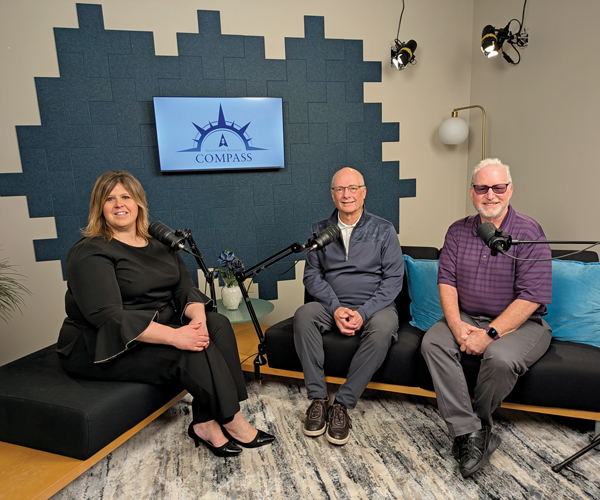It’s been said that shared pain is not paralyzing, but liberating. It causes people to come together to confront and extinguish their hurt, to overcome in the face of all odds. But such common journeys rarely end. And if they do, it’s likely only in childhood fiction.
When the Cuyahoga River caught fire in 1969, it was a source of civic pain and embarrassment that spread across all of Northeast Ohio. It also caused local community, civic, nonprofit and government leaders to come together in a way Cleveland had never seen before. Today, the river that once caught fire is a source of abundant civic pride and urban recreational opportunities. The numerous world-class entertainment venues that line the Cuyahoga’s banks offer views and an ambiance that are truly unique anywhere in the world.
Like any dynamic urban environment, the Flats that line the Cuyahoga have a checkered history — one of birth, entropy and rebirth — always rising out of the ashes of a fire that once denigrated the city’s civic pride. Yet, at the area’s heart beats a hardworking industrial river ripe for reimagination.
“The Flats is absolutely critical to travel and tourism in this town,” says Michael Deemer, president and CEO of Downtown Cleveland Alliance (DCA), who also serves on the board of an organization called Flats Forward. “We are very fortunate to have not one but two waterfronts: the lake and the river.
“Obviously, we pay a lot of attention to the north coast and the lakefront, but our riverfront is a huge asset. Now, with the trail system that has been built and developed and water recreation and the green space that is being built, all of these things become important not just to the Flats, but our entire city.”
“In my opinion, the Flats has always been an integral part of downtown, says Yvette Ittu, president of Cleveland Development Advisors, an affiliate of the Greater Cleveland Partnership (GCP). “There is also an expectation when people come to our city that the Flats play an integral role in our downtown and in the vibrancy of our entire community.”
The Flats also plays a key role in the city’s competitive profile.
“Being on both the lakefront and the riverfront is a competitive advantage for our city,” says David Gilbert, president and CEO of Destination Cleveland. “If you think about it historically, it’s the reason our city exists. You can’t just create a lake to be on or a river to be on.
“Research shows that people gravitate to water, so it is important to continue to develop our lakefront and riverfront in ways that will allow people to be near or on the water for both residents and visitors. It is critical for our city in the short and long term.”
The Flats is continuing to grow, with new development on an area known as the Scranton Peninsula.
“The new developments along Scranton Peninsula expand visitor experience options and drive additional traffic to the Flats district,” Gilbert says. “The connectivity offered by the Towpath Trail extension and Cleveland Foundation Centennial Link Trail combined with the recent addition of BrewDog Cleveland Outpost and upcoming Great Lakes Brewing Co.’s production facility and riverfront brewpub show how, by utilizing existing space along and capitalizing on one of our greatest assets — our beautiful waterfront areas — we can continue to drive economic growth for the community and make Cleveland a desired place to visit, live and work.”
In addition to BrewDog and Great Lakes Brewing Co.’s new facility, there are at least two residential developments planned for the Scranton Peninsula that will bring in excess of 600 apartments and townhomes to the area — an entirely new, vibrant and self-sustaining urban neighborhood that will be added to Flats East and Flats West.
Simply maintaining the Flats as we know it today is no easy task. Development along the river requires a series of complex transactions with numerous deal breakers along the way. Finding solutions requires an extensive collaboration of stakeholders, each with a vested interest in the area that stretches from the lakeshore, along the Cuyahoga to Cleveland-Cliffs steel mill.
Founded in 2016, Flats Forward is an organization that was established through public/private discussion with a mission of creating a framework plan that represents all of the stakeholders in the Flats. And it is a 501(c)3 nonprofit.
“We have our own board of directors who, by design, represent all of the stakeholder constituencies,” says Jim Haviland, executive director of Flats Forward. “The largest of those is obviously industry and maritime, so we have nine seats on our board for that constituency. Then we have tourism, entertainment and residential. But what really makes it all effective is that we have all of our partner organizations on our board, as well as a representative of Cleveland City Council.”
That representative would be Ward 3’s Kerry McCormack.
The rest of the board reads like a who’s who of the movers, shakers and makers in Cleveland. They are all needed, says Haviland, to maintain the delicate balance between industrial, maritime, recreational, entertainment and residential interests in the Flats.
“One of our core missions is to promote the river from both points of view,” adds Haviland. “First, that it is a working river, but also to represent the ever-increasing recreational use of the river.”
In that sense, Joshua Allen, who runs Great Lakes Watersports, is joining the board to help represent the recreational component.
“We are very excited to have him because clearly his business is thriving,” Haviland says.
It should also come as no surprise that Michael Ferry, who runs the Foundry, is also on Flats Forward’s board. His business offers another recreational opportunity you’ll read about in the pages that follow.
“The fact that the Cuyahoga has been voted one of the best urban rivers in the country for kayaking demonstrates that people are really starting to make use of the river,” adds Haviland, citing the river’s selection last year by USA Today. “That means education is critically important. Whether they are paddlers or recreational boaters, we need to educate people on how to react when they see a giant freighter coming right at them.”
A Working River
While the Cuyahoga River and its maritime traffic provides one of the most unique backdrops for entertainment facilities and folks enjoying recreational activities on the river, it is first and foremost a federal shipping channel. That means that nonprofits such as Flats Forward also have to work with law enforcement and other government agencies that have jurisdiction on the river. That can mean everybody from the U.S. Coast Guard to the Ohio Department of Natural Resources (ODNR), Cleveland Police Department, Sheriff’s Department and the Port of Cleveland, which already has a role on the nonprofit’s board occupied by Michael Friedman, president and CEO.
Thanks in large part to the recent success of the Cleveland-Cliffs Cleveland Works steel mill, freighter traffic on the river is on the increase. The Port of Cleveland saw a 69% increase in tonnage across its docks in 2021 compared to 2020. This surge was attributed to significant increases in noncontainerized goods, containerized cargo and iron ore shipments to Cleveland-Cliffs.
Maintaining one of the busiest ports on the Great Lakes is a task unto itself, and the Port of Cleveland takes its role in the Flats very seriously.
“Safety is our primary concern,” says Jade Davis, vice president of external affairs for the Port of Cleveland. “We help coordinate the removal of flotsam and jetsam to maintain safe navigation. We coordinate the removal of obstructions and take an active part in safety training and the warnings you see along the river. We also work directly with Flats Forward and DCA. We sponsor the Fast Start program at Davis Aerospace and Maritime High School, where they teach safety. By teaching students while they are in school, we are creating folks who will be working and recreating along the river in the future.”
The Port of Cleveland’s board of directors voted earlier this summer to approve a settlement involving a key piece of Irishtown Bend along the river as part of a project that will stabilize the hillside and eventually help create a large public park overlooking the Flats.
“Once again, our work was all about safety,” Davis says. “Our work involved maintaining the hillside to keep it from sliding into the river, and to stop the calving of rocks off of the hillside into the river, which would have detrimental impacts on both the large and small vessels that use the river. But our work also helps protect the area from a potentially massive hill slide, which might cause flooding and other environmental issues.”
At press time, a county judge had blocked the Port of Cleveland from swift pursuit of the George’s family property atop Irishtown Bend.
The issues along Irishtown Bend offer clues as to the natural impediments to development along the river.
“Historically, one of the issues surrounding development along the riverfront is the condition of the bulkhead along the river, which runs all the way down to Cleveland-Cliffs,” says Debbie Berry, senior vice president of major projects and real estate development at Greater Cleveland Partnership. “Freighters use the river and their thrusters when they navigate. Then you have all of the recreational traffic running so close to the bulkhead. So it gets old and deteriorates quickly. The good news is that the Port Authority just completed a comprehensive condition assessment both above and below the water so collectively, we can better understand where the issues are.”
Like a sidewalk in a suburban city, the property owner adjacent to the bulkhead is both the owner and the entity responsible for the condition of the bulkhead.
“And if that bulkhead is failing, it can be a very costly endeavor, which can cause the value of the property to go down,” Berry adds. “Sometimes, the property owner might not be able to make the investment.”
This could scrap an entire development deal.
“So collectively, we need a number of entities working together to see if we can create a strategy where we can find public dollars that can be invested in this highly important infrastructure,” says Berry. “But that would also require that property owners, in some form or fashion, create public access along the waterway.”
The late Scott Wolstein did this masterfully with his Flats East Bank development. Wolstein clearly set the example of how riverfront properties can be developed. But such development takes time due in large part to the complex nature of the issues and parties involved. And many of those parties prefer to work behind the scenes, shunning the limelight while working toward a greater goal.
New Plans for Scranton Peninsula
The new Scranton Peninsula development is an excellent case in point. Thunderbird is a large, 21-acre mixed-use development planned on the peninsula that includes residential, office, retail and light manufacturing. It takes up at least a quarter of Scranton Peninsula and includes the possible construction of more than 600 apartments and townhomes; the renovation of an old warehouse to office space called the Avian at Thunderbird; a new production and retail facility for Great Lakes Brewing Co.; and BrewDog Cleveland Outpost, a large bar that opened at the end of last year and is already pulling in huge crowds.
The project is owned by East-West Alliance Thunderbird, a partnership of two companies.
“What is happening on the peninsula is a realization of a mixed-use plan that we created several years ago,” says Matthew Weiner, who is co-manager of East-West Alliance along with Sergey Kuznetsov. “It is really coming to fruition exactly the way we planned it.”
One of the project principals, says Weiner, is Fred Geis, a household name in the Cleveland development community.
“He actually brought us all together and originally identified the project,” Weiner says. “Working with Fred is kind of like being on a football team. You go right into the end zone and wait for someone to throw you a touchdown pass.
“He got us off to a great start because he is the person who brought Great Lakes Brewing Co. into the transaction.”
Entrepreneurs and beer barons brothers Pat and Dan Conley, owners of Great Lakes Brewing Co., purchased 8 acres for a potential expansion project on the peninsula. While they are being uncharacteristically quiet about the project, the pair confirmed they have already received an important brownfield remediation grant — yet another issue facing many of the developers and investors in the Flats.
“We are appreciative of the brownfield grant we received to support the cleanup and remediation of land on Scranton Peninsula, an important step in the process which we plan to begin later this summer,” the brothers said in a prepared statement for Community Leader. “While we don’t have additional updates to share at this time, we still believe in the Scranton Peninsula’s potential for the city of Cleveland, and we are excited to see increased interest and development in the area.”
This, of course, starts with BrewDog, one of the Flats’ newest and most exciting brew pubs, which you’ll read more about later in our entertainment piece.
“The addition of BrewDog has really put a lot of energy into the whole project,” Weiner says. “It has brought a huge amount of attention to the peninsula.”
Although Scranton Peninsula represents the future for Flats development, recreation on the river has become increasingly popular. Simply put, the Cuyahoga has become a great place to play.




